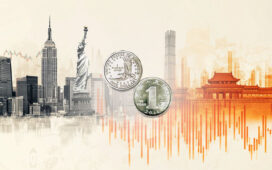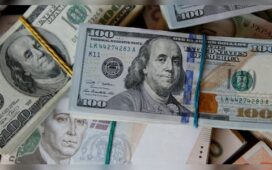Others, conscious that the US relies on foreign capital inflows to fund its yawning (and rapidly growing) government deficits and debt and enable the government and US citizens to live beyond their means, won’t view the apparent crack in the value of the dollar and the US markets’ status as the world’s safe haven quite so positively.
In the near term, the weaker US dollar also means the inflationary impacts in the US of Trump’s trade war on the rest of the world will be exaggerated. A strong dollar, by making imports cheap in US dollar terms, would muffle the impact on inflation.
‘European leaders have recognised the window of opportunity opened by America’s self-destructive trade policies.’
The likely effects of Trump’s war are reflected in this week’s downgrading of the outlook for global and US growth by the World Bank, which sees global growth slowing from 2.8 per cent last year to 2.3 per cent and growth in the US economy halving from 2.8 per cent to 1.4 per cent.
That outlook, if it eventuates, would provide even less reason to invest in the US and would result in an even greater reduction in demand for US dollars.
Does that provide an opportunity for the euro? Perhaps, albeit not one that could be easily or quickly realised.
The dollar has reigned supreme as the world’s reserve currency in the postwar era and still does.
Even though the degree of dominance has been waning, it still accounts for about 58 per cent of central bank reserves – it was above 70 per cent in the early years of this century and was still above 60 per cent five years ago – and about 55 per cent of trade invoicing is denominated in US dollars.

The US dollar has depreciated about 10 per cent this year.Credit: Bloomberg
The euro ranks second on both counts, with a 30 per cent or so share of reserves and a similar share of trade financing.
The challenge for the European Union, if it wants to challenge the dollar’s status, is that, while it might have the “next best” currency, it lacks some of the foundations that would make it the reserve currency.
Loading
It does have a floating exchange rate, no capital controls, an independent and respected central bank and an independent and respected judicial system.
It doesn’t have deep and liquid capital markets nor a single economy that is growing consistently and strongly, nor does it have current account deficits to expand the supply of euros – the European Union consistently runs current account surpluses (and hence is a major target for Trump’s tariffs).
The European capital markets are fragmented and shallow – European companies rely on banks rather than markets as their primary source of funding – and the condition of the underlying economies varies considerably.
The closest thing the EU has to a US Treasury bond is German bunds but, where the US Treasury market has about $US28 trillion ($43 trillion) of securities on issue, the market for bunds is only about €1.8 trillion (about $3.2 trillion).
That market, thanks to the historic decision to reform the country’s “debt brake” in order to use debt financing for what might be a €600 billion increase in military spending, will grow, but it would still remain small relative to the US Treasury market.
Loading
What could the EU do to create a deeper bond market? It could issue eurobonds, or debt raised on behalf of all its members and backed by all their economies.
It has toyed with that idea for decades and, indeed, created a eurobond facility of up to €800 billion to help member countries recover from the pandemic, although those bonds are supposed to progressively mature and disappear by 2058.
Germany has historically been opposed to the issuance of collective EU debt. Its strict fiscal discipline means it can borrow more cheaply than other EU members and pay lower interest rates on its debt. With eurobonds, it would pay more and effectively be subsidising the rest of the EU.
The prize for the EU as a whole – a greater share of world reserves, a more stable currency in stressful times, cheaper funding generally and therefore greater economic growth and the geopolitical benefits from having a reserve currency – is, however, worth striving for.
The EU could do more trade in euros – it buys a lot of energy but pays for it almost exclusively in US dollars, for instance – it could issue a digital euro to facilitate global transactions, and it could integrate its economies and policies more deeply.

While the European Union has the “next best” currency, it lacks some of the foundations that would make it THE reserve currency.Credit: AP
It could also do as the US Federal Reserve Board has done in financial crises, and create permanent swap lines with its major trading partners to provide euro liquidity in moments of stress. That would bolster confidence in the currency.
It is improbable that the euro could displace the US dollar as the world’s reserve currency in anything other than the truly long term.
Loading
It could, however, increase its share of global reserves and transactions and share some of the dollar’s “exorbitant privilege” – the ability to borrow cheaply without any real limits, the haven status in a crisis, the ability, if they ever transpired, to run trade deficits without any fear of a balance-of-payments crisis, and, above all, the enhanced geopolitical authority the EU has always sought.
European leaders have recognised the window of opportunity opened by Trump’s self-destructive trade policies – it’s been a growing topic of conversation in Europe since the “Liberation Day” tariffs announcement – but have also acknowledged the complexities and obstacles to taking advantage of it.
Still, small but important steps could be taken, with eurobond issuance at the forefront and, with the EU members committed to ramping up their defence spending in response to Russia’s invasion of Ukraine, this could be an instance where, thanks to Trump and Vladimir Putin, opportunity and need start to converge.


